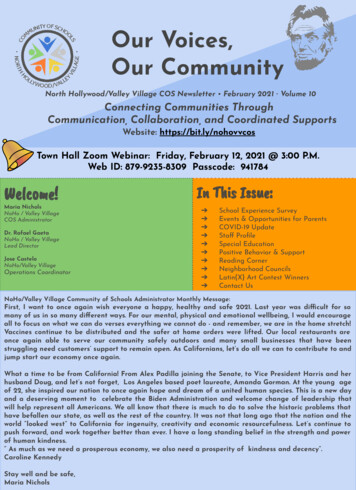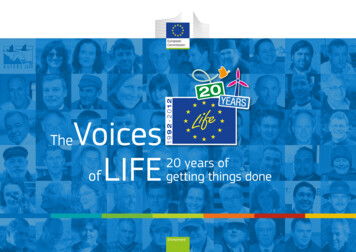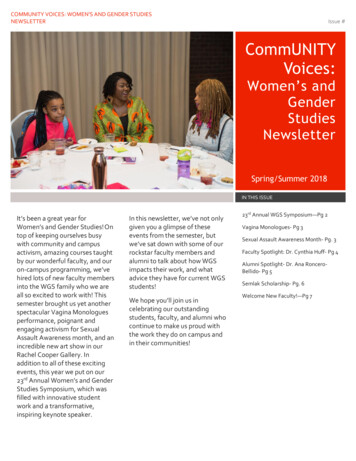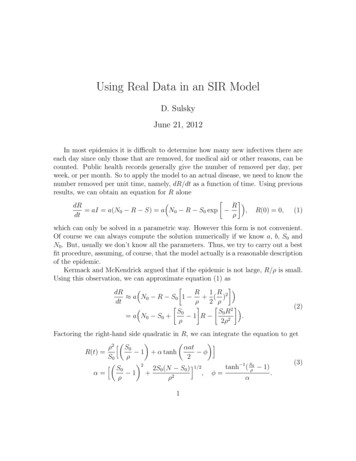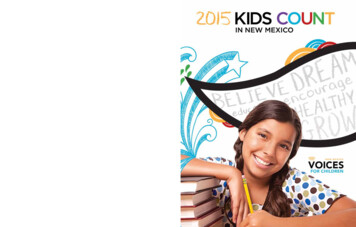
Transcription
NM Voices for Children 2012 Children’s Charter:Our Vision for theNext Generation1. All children and their families are economically secure. ll children and their families have a high-quality2. Acradle-to-career system of care and education.3. A ll children and their families have quality health careand supportive health programs.4. A ll children and their families are free from discriminationbased on race, ethnicity, religion, disability, gender,sexual orientation, or country of origin.5. A ll children and their families live in safe andsupportive communities. ll children and their families’ interests and needs are6. Aadequately represented in all levels of governmentthrough effective civic participation and protectionof voters’ rights.7. A ll children and their families’ needs are a high priorityin local, state, and federal budgets and benefit from atax system that is fair, transparent, and that generatessufficient revenues.
ACKNOWLEDGEMENTSNEW MEXICO VOICES FOR CHILDRENBOARD OF DIRECTORSProduction of New Mexico Voices for Children’s annualKIDS COUNT data book would not be possible withoutthe generous support of the Annie E. Casey Foundationand other donors. Other contributors to this year’sOFFICERSBoard ChairMs. Print. Several key staff members from New MexicoFred Harris, JDDirector, UNM Fred Harris Congressional InternshipVoices for Children provided essential data analysis,Vice-Chairinput, feedback and support, including: Armelle CasauDonald Simonson, Ph.D.International Banking & Finance Advisorpublication include: Eric Griego, Firestik Studio, andand Stephanie Brinker.This research analysis was funded by the Annie E.Casey Foundation. We thank them for their supportbut acknowledge that the findings and conclusionsTreasurerGail Goldstein, M.Ed.Early Childhood Consultantpresented in this report are those of the author(s)Secretaryalone, and do not necessarily reflect the opinionsPatricia Rodroguez, Ph.D.Early Childhood Education Specialist,STG International, Inc.of the Foundation.NEW MEXICO VOICES FORCHILDREN STAFFVeronica C. García, Ed.D.Executive DirectorLori Bachman, MADirector of Organizational Planning,Quality Assurance, and Fund DevelopmentGerry Bradley, MASenior Researcher and Policy AnalystStephanie Brinker, Ph.D.VolunteerArmelle Casau, Ph.D.Policy and Research AnalystCathy CavinMEMBERSJavier Aceves, MDChief, Division of General Pediatrics, UNMDebra L. BacaVice President, Youth Development, Inc.Marilyn Hill, MPADeputy State TreasurerRobert P. McNeill, JDRobert P. McNeill Law OfficesDiana Valdez, Ph.D.Psychologist, Bernalillo Public SchoolsFrances Varela, RN, MSN, MALASPresident, Varela Consulting GroupFund Development SupportLuis Vargas, Ph.D.Matthew Cross-GuillenPsychotherapist, UNM Children’sPsychiatric HospitalBernalillo County Place Matters Community Outreachand Education CoordinatorJames C. Jimenez, MPADirector of Policy, Research, and Advocacy IntegrationBill Jordan, MASenior Policy Advisor/Governmental RelationsSharon KayneCommunications DirectorBrian UrbanFund Development, Outreach,and Membership CoordinatorAmber Wallin, MPANew Mexico KIDS COUNT DirectorSheri Williams, Ed.D.Assistant Professor of Educational Leadership, UNM
Table of ContentsTHE RACE TOWARD EQUITY FOR ALL CHILDREN. . 4TRENDS AND RANKINGSEconomic and Well-BeingChildren in Poverty. 8Parental Employment. 10High Housing Cost Burden. 12Disconnected Youth. 14EducationPreschool Enrollment. 16Reading and Math Proficiency. 18High School Graduation. 21HealthLow Birth-Weight Babies. 22Children without Health Insurance. 24Child and Teen Death Rates. 26Teen Alcohol and Drug Abuse. 28Family and CommunityChildren in Single-Parent Families. 30Parents without a High School Diploma. 32Children Living in High-Poverty Areas. 34Teen Birth Rate. 36TABLES AND GRAPHSEconomic Well-Being: Overall PovertyNew Mexicans (All Ages) Living in Poverty by Year. 38New Mexicans (All Ages) Living in Poverty by Race/Ethnicity. 38New Mexicans (All Ages) Living in Poverty by County. 38Economic Well-Being: Households Receiving SNAP BenefitsHouseholds Receiving SNAP Benefits by Race/Ethnicity. 39Households Receiving SNAP Benefits by County. 39Economic Well-Being: Median Household IncomeMedian Household Income by Race/Ethnicity. 40Median Household Income by County. 40Economic Well-Being: Tribal AreasSelected Indicators of Economic Well-Being for Tribal Areas. 41Education: EnrollmentTotal Enrollment and Percentage of Students Eligible for Free/Reduced-Price Meals by School District. 422New Mexico Voices for Children
Education: Reading and Math ProficiencyStudents Meeting or Exceeding Expectations on New Mexico’s PARCC English Language Arts andMath Assessments by Grade and School District. 44Education: AttendanceHabitual Truancy and Dropout Rates by School District. 46Education: Graduation RatesHigh School Graduation Rates by Selected Status and School District. 48Health: Prenatal CareBirths to Women Receiving No Prenatal Care by Selected Status and County. 50Women Receiving No Prenatal Care by Race/Ethnicity. 51Women Receiving Prenatal Care in the First Trimester by Race/Ethnicity. 51Health: Infant MortalityInfant Mortality Numbers and Rates by County. 51Health: Child Health InsuranceChildren without Health Insurance by Income Level and County. 52Children and Youth (Younger than 21 Years) Enrolled in Medicaid by County. 53Health: Child AbuseSubstantiated Child Abuse Allegations and Investigations by Type of Abuse and County. 54Family and Community: PopulationChild Population by Race/Ethnicity. 56Population by Age and County. 57Family and Community: Types of FamiliesFamilies by Householder Type and County. 58Families by Householder Type and Tribe or Pueblo. 59Family and Community: Adult EducationAdults (Ages 25 and Older) by Educational Attainment Level and County. 60Adults (Agess 25 and Older) by Educational Attainment Level and Tribe or Pueblo. 61METHODOLOGY. 62MAJOR DATA SOURCES. 64OTHER DATA SOURCES. 662015 Kids Count Data Book3
The Race TowardEQUITYfor All ChildrenAll children—regardless of social and economic status, race or ethnicity—should have the best possible shot at reaching their full potential. For children,the possibilities are limitless, but one’s potential is not achieved by accident.Every child needs the opportunities and support systems to reach their goals.Kids born into middle- and upper-income families are likely to have thoseopportunities and support systems. Children born into poverty are not. If wewant poor children to thrive, to become the best people they can be, we mustensure that those opportunities and support systems are there for them too.The data in the following pages tell the story of childin four domains: economic well-being, education,well-being in New Mexico. For too many children, theyhealth, and family and community. In 1995, New Mexicotell a tale of struggle. The numbers show us where wewas ranked 40th among the states for child well-being,stand and where we need to improve, and they servethe best our state has ever fared. By 2009, we hadas a tool and a resource for policy-makers, journalists,dropped to 43rd. In 2013, for the first time ever, weand advocates to ensure kids’ voices are heard. Wewere ranked last for child well-being. Currently,invite readers to harness the power of data in theNew Mexico ranks 49th among the states on overallfight to improve the status of New Mexico’s kidschild well-being.and families.This report shines a light on our ranking, indicatorWHERE DO WE STAND?NEW MEXICO’S KIDS COUNT STORYby indicator, shows how the data in each area havechanged over time, takes a look at how counties, tribalareas, school districts, and racial and ethnic groups4Each year, the Annie E. Casey Foundation’s nationalfare in the indicators measured, and recommends someKIDS COUNT program ranks the 50 states in terms ofproven steps we can take to improve our kids’ and ourchild well-being. States are measured on 16 indicatorsstate’s futures.New Mexico Voices for Children
Too many in New Mexico have become complacentabout our state’s poor standings, but enough isCHILD POPULATION BY RACE/ETHNICITY (2014)enough. We must focus on making improvements.Our kids are not all right, and we can and must dobetter by them. Our future depends on it—but we mustmake the necessary investments today. In order toimprove child well-being in New Mexico and guarantee12%NativeAmerican1% 1%Asian Other Racesour state’s future success, we must make childrena priority, champion racial and ethnic equity, andfocus on implementing two-generation solutions thatsimultaneously bolster kids and their families.2%Black orAfricanAmerican25%Non-HispanicWhiteWHAT CAN WE DO?PUT CHILDREN FIRST59%Too often and for too long, we have treated childrenHispanicas lesser priorities in policy decisions. Many fiscalpolicies are targeted towards businesses to thedetriment of other priorities. When it comes tochildren, some lawmakers take a wait-and-seeattitude, as though childhood can be put on holduntil other priorities have been met. But we can noSource: U.S. Census Bureau, American Community Survey, 2014, Tables B01001and B01001 B, C, D, E, F, G, H, and Ilonger afford to wait for good fortune to trickle downto our kids. New Mexico’s children—the state’s futuregenerations—are in crisis now. We must put kids firstin all policy decisions.of our children to face such adversity and possiblyfail to meet their full potential. Their future and oursChildren’s chances of being healthy, doing well independ too much upon it.school, and growing up to be productive andcontributing members of society are tied to theirLuckily, we know what works. High-quality earlyexperiences in the early years—from before birth upchildhood programs like home visiting, child care, andthrough age five. And in New Mexico, too many youngpre-K lead to improved child well-being and are linkedchildren do not always get enough to eat, go withoutto significant long-term improvements for childrenthe kind of early childhood care and education that willand savings for states. So first and foremost, we mustput them on the path to success, and are held back byinvest more in high-quality early childhood programsthe consequences of living in poverty. Nearly one-thirdnow. Every year that we fail to invest enough money toof our children live at or below the poverty level (justserve all vulnerable children means more kids who are 24,250 for a family of four) and New Mexico now haslikely to enter school unprepared to learn.the highest rate of child poverty in the nation.We also need to align these programs with publicThere is an undeniable correlation between povertyeducation, sufficiently fund K-12 education, andand poor outcomes in health and education, andsupport community schools and school-based healththere is no doubt that many aspects of poverty—centers. We also know that when parents are betterchronic stress, familial instability, and the lack ofeducated, their children do better in school and life,economic security, among them—have long-lastingso we need to make college affordable and putand powerful effects on children, the impacts of whichmore adults on career pathways to improve theircontinue into adulthood. By the same measure,employability. And in order to ensure that thosegrowing up in positive, secure environments is linkedchildren with the fewest resources can still pursueto improved health and education outcomes, and is keytheir dreams, we need to invest in programs thatto successful community and economic development.target improvements towards low-income, and racialKnowing this, we cannot afford to allow nearly a thirdand ethnic minority families and children.2015 Kids Count Data Book5
NEW MEXICANS LIVING IN POVERTY BYAGE AND RACE/ETHNICITY (2014)All across the nation children of color are laggingbehind in economic well-being, education, and healthoutcomes. Racial and ethnic disparities exist in nearlyPercentage of New Mexican Families35%more likely to live in poverty a
All children and their families have quality health care and supportive health programs. 4. All children and their families are free from discrimination based on race, ethnicity, religion, disability, gender, sexual orientation, or countr




